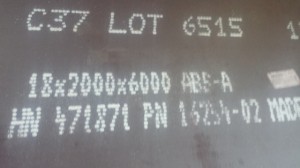The naval board and the classification societies of the naval industry

Naval plate is a thick hot-rolled plate, with a high resistance to corrosion and abrasion, used in the naval industry for the construction of ships and their various component parts.
In recent years, greater importance has been given to the safety and durability of ships, as well as to the protection of the sea environment.
Hot-rolled naval plate sheet is classified into two categories:
1. Steel plate with normal strength – has a minimum yield strength value of 235 N/mm2
Depending on the temperature at which resilience is normalized, three groups are identified:
– group A, with resilience standardized to O degrees Celsius;
– with group D, with resilience standardized to -20 degrees Celsius;
– from group E, with resilience standardized to -40 degrees Celsius.
2. High-strength steel sheet – has a minimum yield strength between 315 and 390 N/mm2.
This group includes steels for shipbuilding supplied in three levels of resistance. Each level is divided by steel brands, in category A, D, E:
– strength level 32 – symbolized A32, D32, E32, with yield strength 315 N/mm2;
– with strength level 36 – symbolized A36, D36, E36, with yield strength 355 N/mm2;
– strength level 40 – symbolized A40, D40, E40, with yield strength 390 N/mm2.
Classification societies in the naval industry
They work according to their own naval registers, which impose regulations and restrictions in the field of naval construction. A comparative analysis of these registers shows that for the naval field there is a technical coherence and an equivalence regarding the prescriptions for most of the characteristics. Thus compatible products are made, with a similar level of quality.

The most important Classification Societies in the shipbuilding industry have joined IACS (International Association of Classification Societies). The members of this association are:
ABS – American Bureau of Shipping (USA);
BV – Bureau Veritas (France);
DNV – Det Norske Veritas (Norway);
GL– Germanischer Lloyd (Germany);
KRS – Korean Register of Shipping (Korea);
LRS – Lloyd’s Register of Shipping (UK);
NKK – Nippon Kaiji Kyokai (Japan);
PRS – Polski Rejestr Statkow (Poland);
RINA – Registro Italiano Navale (Italy);
IRS – Indian Register of Shipping (India).
The classification registers are state institutions, organized for the purpose of verifying and confirming the technical condition of transport ships, as well as certifying their ability to navigate safely.
Mainly, the naval classification registers elaborate:
– rules for testing the materials used in the construction of ships, machines and naval installations;
– for determining the dimensions of construction elements;
– after which the construction of ships, machines and naval installations is supervised;
– after which the final acceptance tests of the ship, of the machines and naval installations are performed;
– rules according to which the visits, by the experts of the register, of the ships in operation are carried out, with the aim of ensuring their good technical condition.
The Romanian Naval Authority operates in Romania, which was born through the merger of the Civil Navigation Inspectorate with the Romanian Naval Registry.
Similar articles:
Why is steel used in construction?
<< Inapoi